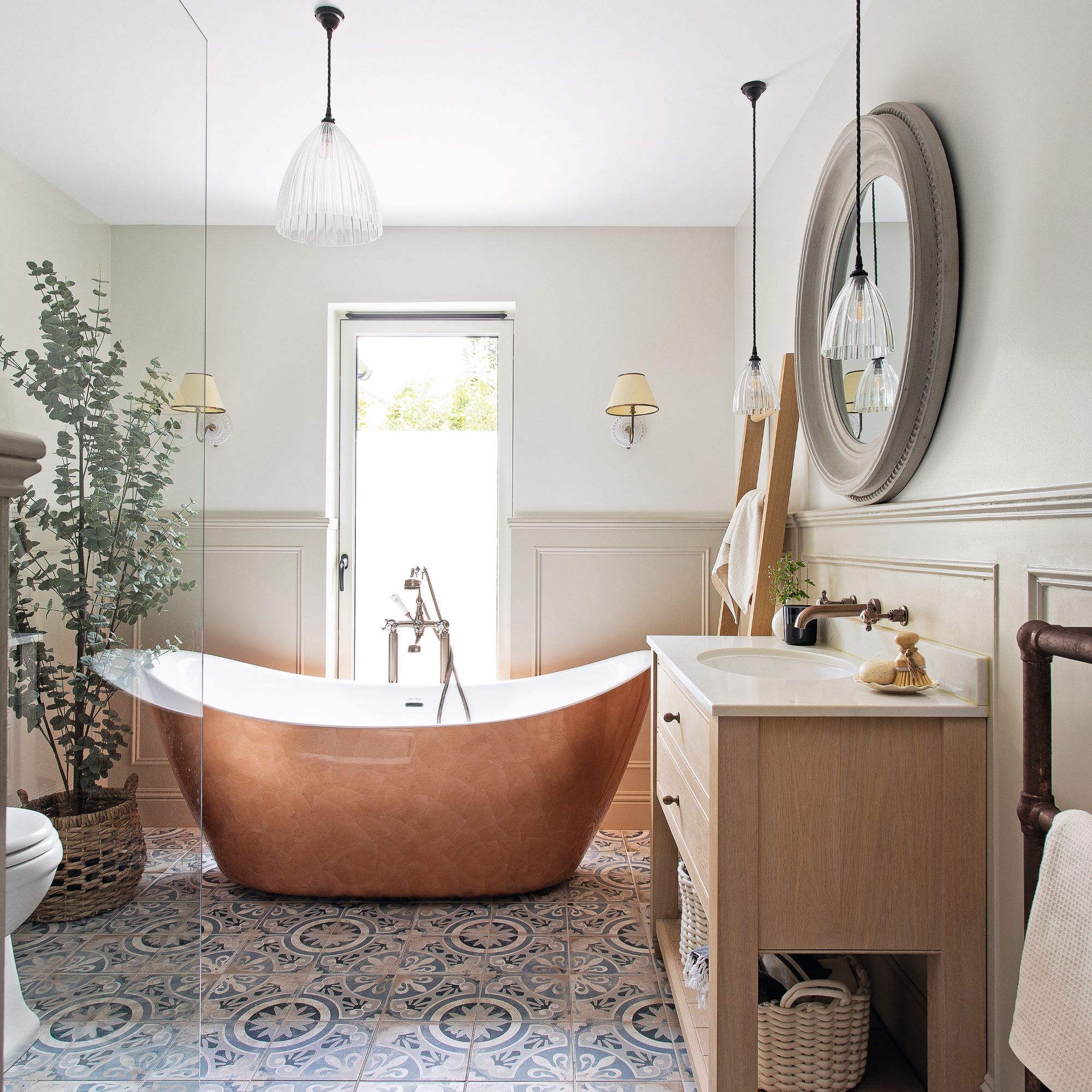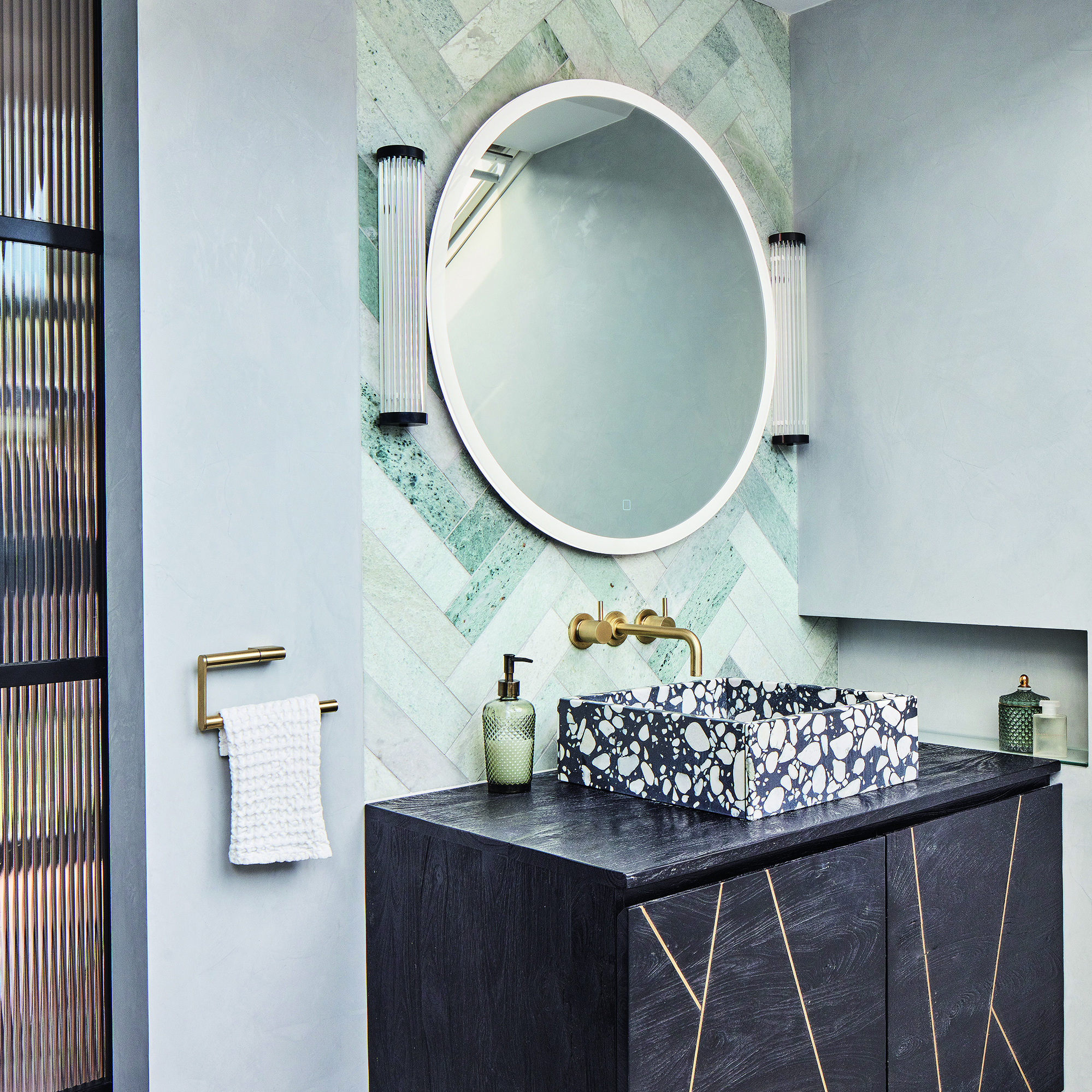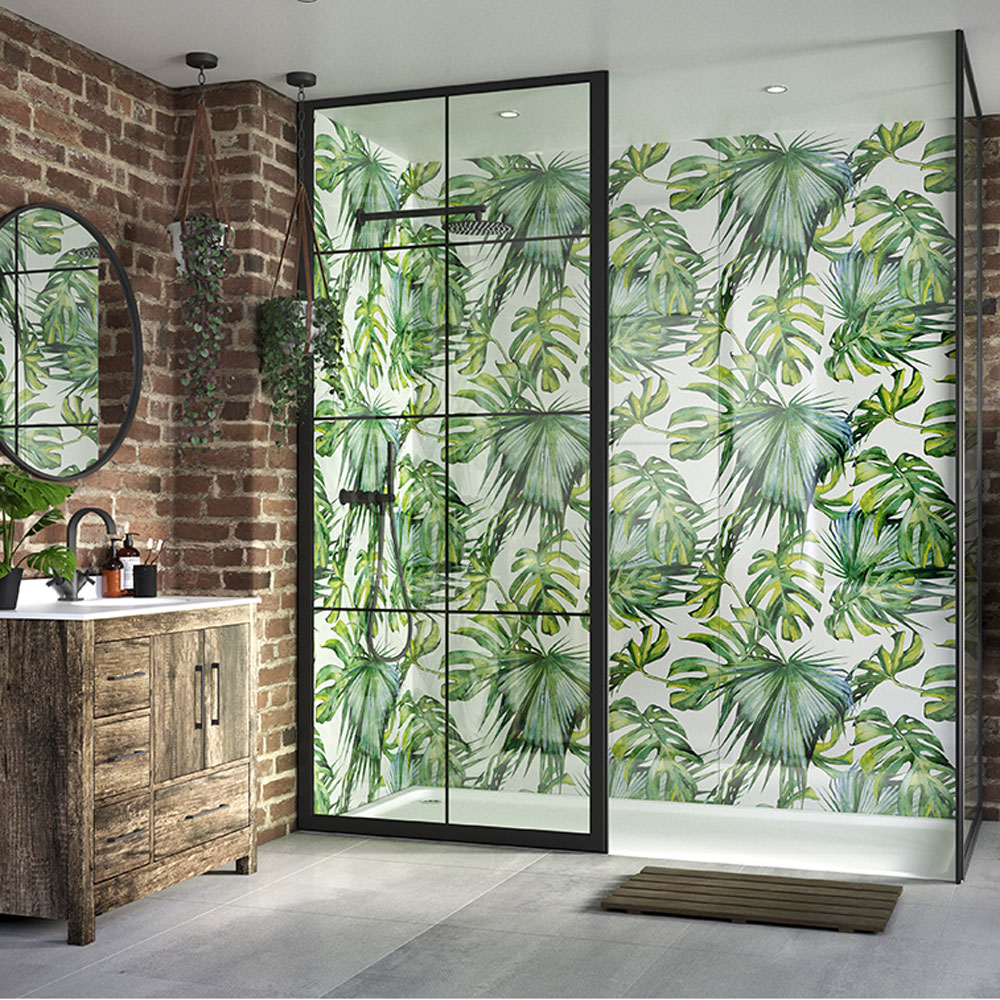11 bathroom lighting ideas to brighten and illuminate your space
Bathroom lighting ideas can be stylish as well as functional
Holly Cockburn

- 1. Layer lighting throughout the bathroom
- 2. Make a statement with a chandelier
- 3. Go for a glass pendant light
- 3. Focus lighting around the mirror
- 4. Create symmetry in a twin bathroom
- 5. Enjoy all the mod cons with an all-in-one mirror
- 6. Enjoy leisurely soaks after dark
- 7. Illuminate sink-side surfaces
- 8. Splash out on extra lighting in the shower
- 9. Be safe with bathroom pendant lights
- 10. Opt for multifunctional bathroom lighting
- 11. Look to different light sources
Bathroom lighting ideas can have a massive impact on a bathroom design - not only on the overall appearance but also on how bright and inviting the space is. Illumination is necessary in any room, but especially in a bathroom where you're starting and ending your days.
It's important to note that when planning lighting in areas where it might come into contact with water, you'll need to look at IP ratings. IP stands for Ingress Protection, meaning that the more susceptible to water penetration light fittings are, then the higher the 'IP' rating they are required to have.
Whether you're looking for a pendant light, wall sconces to flank a mirror or even a lamp idea, these bathroom lighting ideas will have you covered.
Bathroom lighting ideas
As a room where we spend our time either refreshing or relaxing, the right lighting is key to create the correct ambience. Aim for sufficient task lighting in the shower and vanity areas, plus ambient lighting around the bath and in alcoves and niches.
The latest smart lighting controls allow pre-programmed settings. Look out for wireless lighting controls, which is installed without cables and can oversee thermostats, security and audio, if desired.
1. Layer lighting throughout the bathroom

The best lighting schemes rely on light coming from several different sources to create a relaxed and rounded scheme, but one that is functional too. Try to include the three main types of light - which are ambient, task and accent lighting.
Start with recessed spotlights mounted into the ceiling to provide general background lighting. Neat and unobtrusive, they give a uniform level of ambient light and a wide spread so you can manoeuvre the bathroom safely and easily.
Sign up to our newsletter for style inspiration, real homes, project and garden advice and shopping know-how
After ambient lighting, think about task lighting and specific areas that need to be illuminated so that you can see what you are doing, such as around the mirror or in the lighting in the shower.
Finally, use accent lighting to highlight decorative features such as shelves, artwork or greenery. Accent lighting helps set the mood in a bathroom and will add depth and interest.
2. Make a statement with a chandelier

If you want a bathroom design that is really going to wow, then don't discount a chandelier. Although typically used in living rooms or hallways, a chandelier will make your bathroom feel instantly luxe.
To contrast a glitzy look, opt for sleek matt black fittings to dial into a modern bathroom aesthetic.
3. Go for a glass pendant light

Lighting can play a huge part in making a small bathroom look larger. Particularly if a bathroom is north-facing and doesn't receive much natural light, you'll need to rely on artificial sources to create a bright and spacious atmosphere.
Glass pendants are great for this. The clear light fitting will help bounce light across the room and reduce any visual distraction from the ceiling, making a bathroom feel super pared-back, calming and bright.
3. Focus lighting around the mirror

A well-planned bathroom with mirror lighting is essential so you can see what you’re doing properly, whether putting on make-up, brushing your teeth, or shaving.
Avoid placing ceiling lighting directly above and in front of the mirror which can create glare and cast unflattering shadows. If your bathroom mirror idea is centred above the sink, position light fittings on either side of the mirror at eye level and as close to your face as possible, which will give a more flattering, even glow.
Mimic the effect of natural light at a bathroom mirror, by opting for bulbs that offer clear, bright light that won’t appear yellow or dull.
4. Create symmetry in a twin bathroom

Ensure that there is adequate lighting at twin basins and vanity units by installing extra wall lights, either side of each mirror, to cover the full width of the area. Neat column wall lights won’t protrude into the space too much and will cast light evenly up and down the face.
Alternatively, if you have a very wide bathroom mirror with no breaks in between, opt for a pair of column lights positioned horizontally above the mirror, or one single bar-style fitting running the full width of the mirror.
5. Enjoy all the mod cons with an all-in-one mirror

Instead of installing separate light fittings to illuminate the mirror area, opt for a mirror with built-in lighting. Incorporating lighting into the mirror ensures even distribution of light around the mirror and it will cast a subtler glow than harsh overhead lighting.
Make your mirror state-of-the-art, by choosing a design with other intuitive features. This one includes colour temperature changing LED illumination so you can alter the mood at a touch, plus Bluetooth connectivity so you can play your favourite bath time tunes through its integrated speakers. A heated pad helps keep the glass steam-free too.
6. Enjoy leisurely soaks after dark

Instead of surrounding the bath tub with candles - which can be a fire hazard if you’re not super-careful - set the mood at night-time with discreet accent lighting to illuminate the bath area instead.
Aside from casting a cosy glow after dark, adding lighting around the tub area will give extra illumination for bathing and is essential in larger bathrooms, where overhead lighting might not be sufficient. Concealed LED strip lighting set into a recess or running along a shelf is discreet and easy to install. Just remember to keep IP ratings in mind when choosing lighting for the bath or shower area.
7. Illuminate sink-side surfaces

Layering lighting throughout the bathroom will enhance the overall mood and provide extra useful illumination in key areas. Installing concealed lights above and below a mirrored cabinet will create a soft ambient glow for putting make-up on, but also come in handy for lighting the area around the basin too.
In a sink-side area like this, lights will need to be splashproof, which requires a minimum IP44 rating. Consider flexible LED strip lighting that simply sticks to the underside of a cabinet or a concealed under-counter strip light that is easily attached.
8. Splash out on extra lighting in the shower

Shower cubicles and walk-in showers will generally need some form of additional lighting to supplement the main lighting source. This could be ceiling spots or indirect lighting set into the walls lower down.
When it comes to overhead shower lighting, recessed lights are best, but they must be designed for use in wet and damp environments. Recessed lights sit flush to the ceiling which ensures damp does not build up and attract mould and they are easy to wipe over and keep clean.
Safety is key in a shower area, with the ceiling height dictating what grade of lighting is safe. Generally speaking, IP65 rating lights are suitable, but your electrician will be able to advise.
9. Be safe with bathroom pendant lights

Chandelier ideas and pendant lights can be used in bathrooms as long as they are not positioned close to water sources (and out of the designated zones). However, generally speaking, lighting with an IP44 rating is always advised in bathrooms.
A pendant light with an IP44 rating, like this one, is splashproof (though not fully waterproof) so can be safely fitted in a bathroom provided it is 60cm outside the perimeter of the bath and to a height of 2.25m from the floor.
10. Opt for multifunctional bathroom lighting

Provide extra lighting in darker areas of the bathroom with clever multifunctional fixtures and fittings. This neat LED wall light has a toughened glass shelf on top that will hold essential toiletries, plus an integral rail below, that has moveable hooks for hanging towels and robes.
11. Look to different light sources

With the correct lighting (avoiding common bathroom lighting mistakes), your room can take on different looks throughout the day, night and seasons. In most rooms, you’ll likely need several types of lighting, as one central light source won’t do every job. This is easily achieved through light layering, where you make use of different types of light sources in each room to suit your needs.
Don’t overlook wall lights – downlighters especially have become very popular, with an array of different styles, and are perfect for adding interest and ambience to a focal wall.
FAQs
What is good lighting for a bathroom?
Essentially good lighting for a bathroom is lighting that serves all purposes. Because we use bathrooms everyday, at all times of the day, the right bathroom lighting idea will ensure you have sufficient light at all times – whether showering or relaxing in the tub.
When planning the lighting for your bathroom, remember that you want it to work equally well at all times of the day and throughout the year. Whether it's dark winter mornings or sunny summer evenings.
How do you light a bathroom properly?
There are three key zones to keep in mind when selecting lighting for your bathroom:
-Zone 0, is inside the bath or floor of the shower. Any fitting used in this zone must be low voltage and be rated at least IP67 which is total immersion proof.
-Zone 1, is the area above the bath or shower to a height of 2.25m from the floor. A minimum rating of IP45 is required, but it is generally accepted that IP65 is to be used.
-Zone 2, is the area stretching 0.6m outside the perimeter of the bath and to a height of 2.25m from the floor. In this zone an IP rating of at least IP44 is required. In addition it is good practice to consider the area around a wash basin, within a 60cm radius of any tap to be considered as zone 2.
For any bathroom area outside these zones, an IP rating isn’t a requirement, although a minimum IP44 rating is still advised.
Choose task lighting, such as overhead spotlights in the shower and around sink units to add maximum coverage. Wall lights and mirror surrounds can welcome focused directional light when using the vanity. Add ambient lighting around the bath and in alcoves and niches. Dimmers or adjustable lighting is key for being able to control the amount of light throughout the day.
Modern smart lighting controls allow pre-programmed settings to make life easier. Try wireless lighting controls, which are installed without cables – a safety consideration to take into account.
Should bathroom lights hang over a mirror?
Bathroom lights over and around mirrors are key for providing focused task lighting when using the mirrors. Whether choosing wall-mounted lights around or above the mirror or incorporating lighting as part of the mirror, as many modern designs will do, illuminating mirrors is key to a well-functioning bathroom space.
Will you be using these bathroom lighting ideas to illuminate your scheme?
Jennifer is the Deputy Editor (Digital) for Homes & Gardens online. Prior to her current position, she completed various short courses a KLC Design School, and wrote across sister brands Ideal Home, LivingEtc, 25 Beautiful Homes, Country Homes & Interiors, and Style at Home.
- Holly CockburnContent Editor